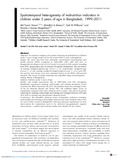Spatiotemporal heterogeneity of malnutrition indicators in children under 5 years of age in Bangladesh, 1999–2011
Citation
Hasan, M. T., Mamun, A. A., Williams, G. M., & Soares Magalhães, R. J. (2018). Spatiotemporal heterogeneity of malnutrition indicators in children under 5 years of age in bangladesh, 1999-2011. Public Health Nutrition, 21(5), 857-867. doi:10.1017/S136898001700341XAbstract
Objective: To examine changes in the spatial clustering of malnutrition in children
under 5 years of age (under-5s) for the period 1999 to 2011 in Bangladesh.
Design: We used data from four nationally representative Demographic and
Health Surveys (DHS) conducted in 1999–2000, 2004, 2007 and 2011 in
Bangladesh involving a total of 24 211 under-5s located in 1661 primary sampling
units (PSU; geographical unit of analysis) throughout Bangladesh. The prevalence
of stunting (height/length-for-age Z-score <− 2), underweight (weight-for-age
Z-score <− 2) and wasting (weight-for-height/length Z-score <− 2) at each PSU
site and for each survey year were estimated based on the WHO child growth
standard. The extent of spatial clustering was quantified using semivariograms.
Setting: Whole of Bangladesh.
Subjects: Children under 5 years of age.
Results: Our results demonstrate that in 1999–2000 most PSU throughout
Bangladesh experienced stunting, underweight and wasting prevalence which
exceeded the WHO thresholds. By 2011, this situation improved, although in two
of the six divisions (Barisal and Sylhet) PSU still exhibited higher levels of
malnutrition compared with other divisions of the country. The pattern of spatial
clustering for stunting, underweight and wasting also changed between 1999 and
2011 both at national and sub-national (division) levels.
Conclusions: We identified divisions where malnutrition indicators (stunting,
underweight and wasting) remain highly clustered and other divisions where they
are more widely spread in Bangladesh. This has important implications on how
interventions for malnutrition need to be delivered (geographically targeted
interventions v. random interventions) within each division of the country

